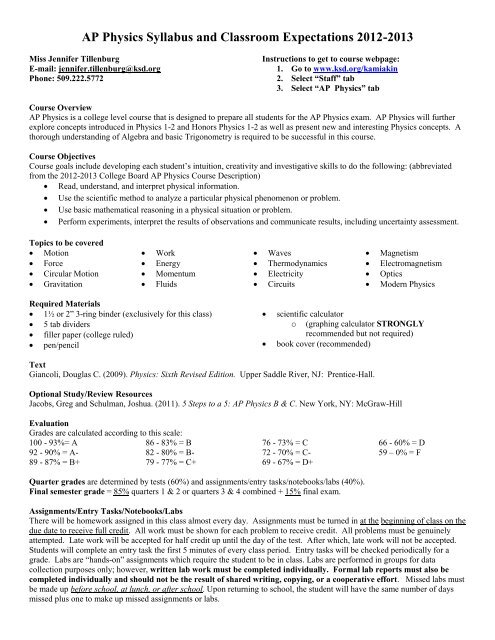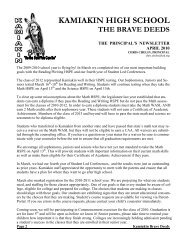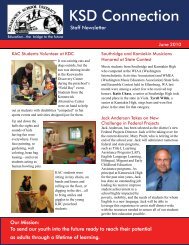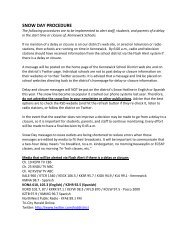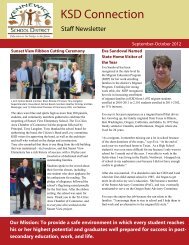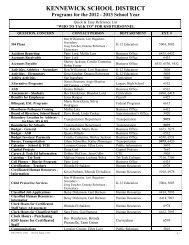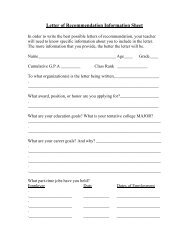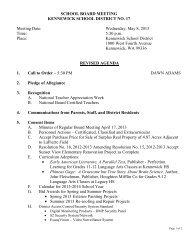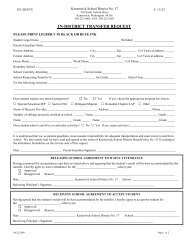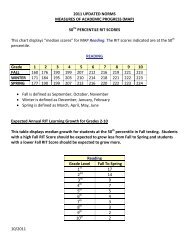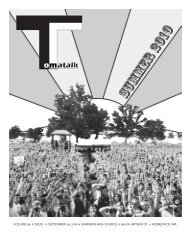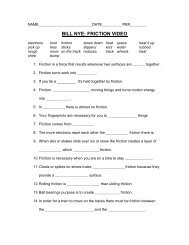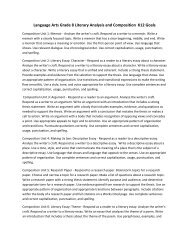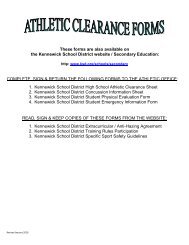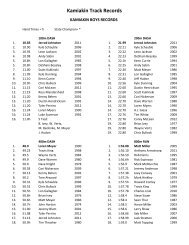AP Physics Syllabus 2012-2013
AP Physics Syllabus 2012-2013
AP Physics Syllabus 2012-2013
Create successful ePaper yourself
Turn your PDF publications into a flip-book with our unique Google optimized e-Paper software.
<strong>AP</strong> <strong>Physics</strong> <strong>Syllabus</strong> and Classroom Expectations <strong>2012</strong>-<strong>2013</strong><br />
Miss Jennifer Tillenburg<br />
E-mail: jennifer.tillenburg@ksd.org<br />
Phone: 509.222.5772<br />
Instructions to get to course webpage:<br />
1. Go to www.ksd.org/kamiakin<br />
2. Select “Staff” tab<br />
3. Select “<strong>AP</strong> <strong>Physics</strong>” tab<br />
Course Overview<br />
<strong>AP</strong> <strong>Physics</strong> is a college level course that is designed to prepare all students for the <strong>AP</strong> <strong>Physics</strong> exam. <strong>AP</strong> <strong>Physics</strong> will further<br />
explore concepts introduced in <strong>Physics</strong> 1-2 and Honors <strong>Physics</strong> 1-2 as well as present new and interesting <strong>Physics</strong> concepts. A<br />
thorough understanding of Algebra and basic Trigonometry is required to be successful in this course.<br />
Course Objectives<br />
Course goals include developing each student’s intuition, creativity and investigative skills to do the following: (abbreviated<br />
from the <strong>2012</strong>-<strong>2013</strong> College Board <strong>AP</strong> <strong>Physics</strong> Course Description)<br />
Read, understand, and interpret physical information.<br />
Use the scientific method to analyze a particular physical phenomenon or problem.<br />
Use basic mathematical reasoning in a physical situation or problem.<br />
Perform experiments, interpret the results of observations and communicate results, including uncertainty assessment.<br />
Topics to be covered<br />
Motion<br />
Force<br />
Circular Motion<br />
Gravitation<br />
<br />
<br />
<br />
<br />
Work<br />
Energy<br />
Momentum<br />
Fluids<br />
<br />
<br />
<br />
<br />
Waves<br />
Thermodynamics<br />
Electricity<br />
Circuits<br />
<br />
<br />
<br />
<br />
Magnetism<br />
Electromagnetism<br />
Optics<br />
Modern <strong>Physics</strong><br />
Required Materials<br />
1½ or 2” 3-ring binder (exclusively for this class)<br />
5 tab dividers<br />
filler paper (college ruled)<br />
pen/pencil<br />
<br />
<br />
scientific calculator<br />
o (graphing calculator STRONGLY<br />
recommended but not required)<br />
book cover (recommended)<br />
Text<br />
Giancoli, Douglas C. (2009). <strong>Physics</strong>: Sixth Revised Edition. Upper Saddle River, NJ: Prentice-Hall.<br />
Optional Study/Review Resources<br />
Jacobs, Greg and Schulman, Joshua. (2011). 5 Steps to a 5: <strong>AP</strong> <strong>Physics</strong> B & C. New York, NY: McGraw-Hill<br />
Evaluation<br />
Grades are calculated according to this scale:<br />
100 - 93%= A<br />
86 - 83% = B<br />
92 - 90% = A-<br />
82 - 80% = B-<br />
89 - 87% = B+<br />
79 - 77% = C+<br />
76 - 73% = C<br />
72 - 70% = C-<br />
69 - 67% = D+<br />
66 - 60% = D<br />
59 – 0% = F<br />
Quarter grades are determined by tests (60%) and assignments/entry tasks/notebooks/labs (40%).<br />
Final semester grade = 85% quarters 1 & 2 or quarters 3 & 4 combined + 15% final exam.<br />
Assignments/Entry Tasks/Notebooks/Labs<br />
There will be homework assigned in this class almost every day. Assignments must be turned in at the beginning of class on the<br />
due date to receive full credit. All work must be shown for each problem to receive credit. All problems must be genuinely<br />
attempted. Late work will be accepted for half credit up until the day of the test. After which, late work will not be accepted.<br />
Students will complete an entry task the first 5 minutes of every class period. Entry tasks will be checked periodically for a<br />
grade. Labs are “hands-on” assignments which require the student to be in class. Labs are performed in groups for data<br />
collection purposes only; however, written lab work must be completed individually. Formal lab reports must also be<br />
completed individually and should not be the result of shared writing, copying, or a cooperative effort. Missed labs must<br />
be made up before school, at lunch, or after school. Upon returning to school, the student will have the same number of days<br />
missed plus one to make up missed assignments or labs.
Notebooks<br />
The student will be required to keep a science notebook which will include the following:<br />
1) Entry Tasks<br />
4) Labs<br />
2) Class Notes<br />
5) <strong>AP</strong> Review<br />
3) Assignments<br />
Notebooks will be checked periodically for completeness and organization.<br />
Tests<br />
Tests are always announced and will be given at the end of each chapter. Missed tests must be made up before school, at lunch,<br />
or after school. Upon returning to school, the student will have the same number of days missed plus one to make up missed<br />
tests. If the student misses 1 or 2 days prior to a test, the student will be expected to take it with the rest of the class, as long as<br />
no new material was presented while he/she was gone.<br />
Attendance<br />
It is the student’s responsibility to get the work the student missed while the student was absent. Always check the calendar for<br />
missed assignments. It will tell the student what we did each day in class. The student has the same number of days the student<br />
was absent plus one to make up the work for full credit. Also, don’t forget to turn in the work that was due from the student’s<br />
absence. After the 13 th absence, a Denial of Class Credit Referral Form will be submitted to the office.<br />
Hall Passes<br />
The student will be given 4 personal hall passes for the semester. The student will use one pass when he/she needs to leave the<br />
room (bathroom, locker, etc.) Extra passes will cost the student time before school, at lunch or after school.<br />
Tardy Policy<br />
A student is tardy if he/she is not in the room when the tardy bell rings. Tardies of more than 10 minutes are considered an<br />
absence.<br />
1 st tardy Warning<br />
2 nd tardy Lunch detention with teacher<br />
3 rd tardy Afterschool detention assigned and parent contacted<br />
4 th tardy and beyond Referral to office for progressive discipline<br />
Electronic Device Policy<br />
The use of electronic devices not directly related to a class activity is not allowed during class time. This includes but is not<br />
limited to cell phones, music players, cameras, electronic games, and tablets. Devices should not be seen or heard – please keep<br />
your device turned off and put away. Parents needing to contact a student can call the office at 509.222.7000.<br />
1 st violation Device taken away and student can pick up after class<br />
2 nd violation Device taken away and student can pick up after school<br />
3 rd violation Device taken away and student can pick up after school only after parent is contacted<br />
4 th violation and beyond Device taken away, turned in to office, parent contacted, parent picks up from office<br />
Classroom Expectations (THE BIG THREE)<br />
1. Make Good Decisions<br />
2. Show Respect<br />
3. Solve Problems<br />
Discipline Policy (steps may vary according to behavior)<br />
Failure to follow classroom rules and expectations may result in the following: Verbal warning/chat, parent/guardian contact,<br />
written paper, detention, and/or referral to office. Referrals to office may result in detention, ISS, or suspension.<br />
Specific Classroom Policies and Procedures<br />
1. At the beginning of class, students should be in their assigned seat, working on the entry task or reading quietly. Students<br />
should not be talking or finishing homework from the previous day.<br />
2. Work should be original and not plagiarized. Cheating can result in receiving no credit, parent contact, and a discipline<br />
referral.<br />
3. No food or drink, except water, and no audible or visible gum.<br />
4. When the dismissal bell rings, students will be dismissed by the teacher once they are seated and quiet.
Please detach and return this page to Miss Tillenburg<br />
By signing and returning this page, I acknowledge that I have read and understand the <strong>AP</strong> <strong>Physics</strong> <strong>Syllabus</strong> and Classroom<br />
Expectations.<br />
Student name (print)_____________________________<br />
Student signature______________________Date______<br />
Parent/Guardian name (print)_____________________________<br />
Parent/Guardian signature______________________ Date______<br />
Parent’s/Guardian’s e-mail address__________________________________________________________________________<br />
Parent’s/Guardian’s daytime phone number___________________________________________________________________<br />
Information that you want me to know about your child (optional):<br />
__________________________________________________________________________________________<br />
__________________________________________________________________________________________<br />
__________________________________________________________________________________________<br />
__________________________________________________________________________________________<br />
__________________________________________________________________________________________<br />
__________________________________________________________________________________________<br />
__________________________________________________________________________________________<br />
__________________________________________________________________________________________


